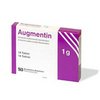Augmentin for sale over the counter. Online order.

Augmentin
Active Ingredient: amoxicillin, clavulanate
Augmentin is used to treat many different infections caused by bacteria, such as sinusitis, pneumonia, ear infections, bronchitis, urinary tract infections, and infections of the skin.
Augmentin as known as: Abiclav, Abiolex, Abiotyl, Acadimox, Acarbixin, Acellin, Aclam, Aclav, Adbiotin, Aescamox, Agram, Aklav, Aktil, Alcevan, Alfoxil, Almacin, Almorsan, Alphamox,
Dosage Augmentin: 1000 mg, 625 mg, 375 mg
Lobar pneumonia is a bacterial infection of a lobe of the lung and its visceral pleura by bacterial flora. This disease is acute. Lobar pneumonia is the most common type of lobar pneumonia, but it can be considered as a separate form of the disease. This is especially important for unspecified infectious agents.
What pathogens cause lobar pneumonia?
The following microorganisms are common causative agents of lobar pneumonia:
- Frenkel-Wekselbaum pneumococcus (the most common);
- Klebsiella pneumoniae;
- staphylococci;
- streptococci;
- Escherichia coli.
There are also options when the lungs are affected by mixed bacterial flora.
How does lobar pneumonia develop?
There are four stages of the disease, which can occur in any order or simultaneously.
- Tide stage. The lung becomes heavier and turns red. With microscopy, you can see full-blooded pulmonary vessels, alveolar effusion with single neutrophils and often bacterial flora.
- Red liver stage. The affected lobe becomes intensely red in color and feels like liver tissue. Under microscopy, the lumen of the alveoli is filled with red blood cells, neutrophils and fibrin.
- Stage of gray hepatization. The surface of the lungs becomes gray-brown in color and becomes dry. Microscopy reveals the breakdown of erythrocytes with purulent-fibrinous exudate, a large number of neutrophils and macrophages. Based on the ratio of exudate components, the following types of gray hepatization stage can be distinguished:
- with an equal ratio of fibrin and leukocytes;
- with a predominance of leukocytes;
- with a predominance of fibrin;
- with a predominance of fibrin and alveolar macrophages.
- Resolution stage. The exudate turns into granular semi-liquid detritus, some of which is absorbed into the blood, some is absorbed by macrophages, and the rest is coughed up.
The first stage lasts approximately 1-3 days, the second and third – from 3 to 5 days, resolution occurs by 7-11 days of the disease. However, in individual cases the stages may last longer.
How often is lobar pneumonia diagnosed?
 Lobar pneumonia most often affects adults (from 18 to 40 years old) and quite rarely affects children. However, the majority of patients are men or boys. The incidence of lobar pneumonia ranges from 3 to 15% of all internal diseases. Due to early antibiotic therapy, the incidence is significantly reduced from year to year. In addition, there are drugs that are highly effective and affordable, making treatment accessible to most people.
Lobar pneumonia most often affects adults (from 18 to 40 years old) and quite rarely affects children. However, the majority of patients are men or boys. The incidence of lobar pneumonia ranges from 3 to 15% of all internal diseases. Due to early antibiotic therapy, the incidence is significantly reduced from year to year. In addition, there are drugs that are highly effective and affordable, making treatment accessible to most people.
Croupous pneumonia is seasonal, with most of them observed in spring and autumn. In children, lobar pneumonia is diagnosed in the spring, less often in the summer.
Who is at risk?
Most often, lobar pneumonia affects people who:
- abuse alcohol;
- live in poor material and living conditions;
- consume insufficient amounts of vitamins and nutrients;
- smoke.
What symptoms are characteristic of lobar pneumonia?
The disease occurs in an acute form, with patients experiencing the following manifestations:
- chills;
- nausea (sometimes vomiting due to intoxication);
- pain in the chest when inhaling;
- frequent dry cough;
- rapid shallow breathing;
- high body temperature, which is replaced by a critical drop;
- viscous, difficult to separate glassy sputum, sometimes mixed with blood.
With lower lobe pneumonia, abdominal pain may occur, and it can be mistaken for acute appendicitis, cholelithiasis or renal colic. Upon examination, there is a lag in the half of the chest where the inflammatory process is located.
If you suspect pneumonia, you should seek medical help, because even in the early stages of the disease, there is a risk of death from Clavulanate Amoxicillin.
How is lobar pneumonia diagnosed?
To make a diagnosis, a physical examination is performed and x-ray and laboratory diagnostics are prescribed. Laboratory diagnosis includes a blood test and sometimes a sputum test to determine the type of pathogen. But, since this method is quite long (24-48 hours), it is advisable to immediately prescribe broad-spectrum antibiotics for treatment, for example: Augmentin (over-the-counter) Clavulanate Amoxicillin.
What treatment is indicated for lobar pneumonia?
Antibiotics are prescribed to treat pneumonia. Also recommended:
- adhere to bed rest;
- drink enough liquid;
- ventilate the room where the patient is.
The drug Augmentin buy based on amoxicillin and clavulanic acid shows good results in the treatment of lobar pneumonia. It can be bought at a pharmacy or ordered online.
Most patients can be treated at home, but in no case should you voluntarily stop a prescribed antibiotic or self-medicate, as this significantly increases the risk of death.
What is special about Augmentin?
Augmentin is a combined broad-spectrum antimicrobial agent, which, due to the presence of clavulanic acid, actively acts even on strains of microorganisms that secrete beta-lactamase.
The drug Clavulanate Amoxicillin order online is well absorbed in the digestive tract and shows the highest effectiveness when taken before meals.
Where can I buy Augmentin at a good price?
In our online pharmacy you can order generic Augmentin – a high-quality analogue of the original drug. Generic Augmentin is not only highly effective, but also affordable. In addition, the drug can be ordered without a doctor’s prescription.
Before you buy generic Augmentin, you should consult your doctor.

